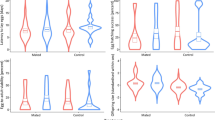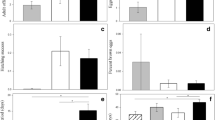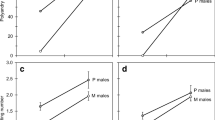Abstract
Production of female gametes is costly; however, there is now wide evidence across different taxa that male ejaculates are also limiting. Thus, multiply mated males may need to partition their ejaculate across successive matings. While more attention has been payed to whether female mating with previously mated males could be sperm limited, there have been fewer studies on depletion of other substances transferred in the male ejaculate such as accessory gland products. Here, we assessed whether male mating frequency affected mating success, copula duration, mating latency, and sperm stored by females. In addition, we measured male testes and accessory gland size across consecutive matings and evaluated the effect of male multiple mating on female fecundity, fertility, and remating propensity in the South American fruit fly, Anastrepha fraterculus. We show that males have the capacity to modulate ejaculate expenditure, and although sperm storage dramatically decreased after the first mating, this had no effect on female reproductive parameters. However, males mating with five consecutive females had smaller accessory glands. Females mated with males who had previously mated five times failed to lay any eggs. This lower propensity to lay eggs could suggest that males become depleted of products synthetized in the accessory glands, including peptides that have an effect on oogenesis and/or egg laying. We discuss our results in terms of cost of production of male accessory gland products and the impact on female fitness according to male mating history.
Significance statement
During insect copulation, males transfer to females’ seminal fluids composed of sperm and accessory gland (AG) products. Sperm depletion over male consecutive matings and its impact on female reproductive success have been explored in the past years; however, AG depletion and its effects on female physiology and behavior remain practically unexplored. We show for the fruit fly, Anastrepha fraterculus, that male multiple matings have a dramatic impact on female fecundity and fertility after males achieve five copulations, and this effect seems mediated by depletion and lack of replenishment of products synthetized in the AG, inferred through their size reduction. In contrast, while sperm transfer was markedly higher for virgin than for multiply mated males, this did not affect female fecundity or fertility, showing that the dynamics of seminal fluid components can differ.






Similar content being viewed by others
References
Abraham S, Goane L, Rull J, Cladera J, Willink E, Vera MT (2011a) Multiple mating in Anastrepha fraterculus females and its relationship with fecundity and fertility. Ent Exp et App 141:15–24
Abraham S, Goane L, Cladera JC, Vera MT (2011b) Effects of male nutrition on sperm storage and remating behavior in wild and laboratory Anastrepha fraterculus (Diptera: Tephritidae) females. J Insect Physiol 57:1501–1507
Abraham S, Cladera JC, Goane L, Vera MT (2012) Factors affecting Anastrepha fraterculus female receptivity modulation by accessory gland products. J Insect Physiol 58:1–6
Abraham S, Liendo MC, Devescovi F, Peralta PA, Yusef V, Ruiz J, Cladera J, Vera MT, Segura DF (2013) Remating behaviour in Anastrepha fraterculus (Diptera: Tephritidae) females is affected by male juvenile hormone analogue treatment but not by male sterilization. Bull Ent Res 103:310–317
Abraham S, Vera MT, Pérez-Staples D (2015) Current sperm competition determines sperm allocation in a Tephritid fruit fly. Ethology 121:451–461
Abraham S, Lara-Pérez L, Rodriguez C, Contreras-Navarro Y, Nuñez-Beverido N, Ovruski S, Pérez-Staples D (2016) The male ejaculate as inhibitor of female remating in two tephritid flies. J Insect Physiol 88:40–47
Arnqvist G, Danielsson I (1999) Copulatory behavior, genital morphology, and male fertilization success in water striders. Evolution 53:147–156
Arredondo J, Tejeda MT, Ruiz L, Meza JS, Pérez-Staples D (2017) Timing of irradiation and male mating history effects on female remating in Anastrepha ludens (Diptera: Tephritidae). Fla Entomol 100:566–570
Avila FW, Sirot LK, LaFlamme BA, Rubinstein CD, Wolfner MF (2011) Insect seminal fluid proteins: identification and function. Annu Rev Entomol 56:21–40
Brent CS, Hull JJ (2014) Characterization of male-derived factors inhibiting female sexual receptivity in Lygus hesperus. J Insect Physiol 60:104–110
Chapman T, Bangham J, Vinti G, Seifried B, Lung O, Wolfner MF, Smith HK, Partridge L (2003) The sex peptide of Drosophila melanogaster: female post-mating responses analyzed by using RNA interference. Proc Nat Ac Sci 100:9923–9928
Chen PS, Stumm-Zollinger E, Aigaki T, Balmer J, Bienz M, Böhlen P (1988) A male accessory gland peptide that regulates reproductive behavior of female D. melanogaster. Cell 54:291–298
Dewsbury DA (1982) Ejaculate cost and male choice. Am Nat 119:601–610
Fedorka KM, Winterhakter WE, Ware B (2011) Perceived sperm competition intensity influences seminal fluid protein production prior to courtship and mating. Evolution 65:584–590
Gavriel S, Gazit Y, Yuval B (2009) Remating by female Mediterranean fruit flies (Ceratitis capitata, Diptera: Tephritidae): temporal patterns and modulation by male condition. J Insect Physiol 55:637–642
Gerofotis CD, Yuval B, Ioannou CS, Nakas CT, Papadopoulos NT (2015) Polygyny in the olive fly—effects on male and female fitness. Behav Ecol Sociobiol DOI 69:1323–1332. https://doi.org/10.1007/s00265-015-1945-6
Gillott C (1988) Arthropoda-Insecta. In: Adiyodi KG, Adiyodi RG (eds) Reproductive biology of invertebrates, Vol. III. Accessory sex glands. Wiley, New York, pp 319–471
Gillott C (2003) Male accessory gland secretions: modulators of female reproductive physiology and behavior. Annu Rev Entomol 48:163–184
Heifetz Y, Lung O, Frongillo JEA, Wolfner MF (2000) The Drosophila seminal fluid protein Acp26Aa stimulates release of oocytes by the ovary. Curr Biol 10:99–102
Heifetz Y, Tram U, Wolfner MF (2001) Male contributions to egg production: the role of accessory gland products and sperm in Drosophila melanogaster. Proc Roy Soc L B: Biol Sci 268:175–180
Helinski MEH, Harrington LC (2011) Male mating history and body size influence female fecundity and longevity of the dengue vector Aedes aegypti. J Med Entomol 48:202–211
Herndon LA, Wolfner MF (1995) A Drosophila seminal fluid protein, Acp26Aa, stimulates egg laying in females for 1 day after mating. Proc Nat Ac Sc 92:10114–10118
Hihara F (1981) Effects of the male accessory gland secretion on oviposition and remating in females of Drosophila melanogaster. Zool Mag 90:307–316
Hodgson DJ, Hosken DJ (2006) Sperm competition promotes the exploitation of rival ejaculates. J Theoret Biol 243:230–234
Jaldo HE, Gramajo MC, Willink E (2001) Mass rearing of Anastrepha fraterculus (Diptera: Tephritidae): a preliminary strategy. Fla Entomol 84:716–718
Katvala M, Rönn JL, Arnqvist G (2008) Correlated evolution between male ejaculate allocation and female remating behaviour in seed beetles. J Evol Biol 21:471–479
Kendall MS, Wolcott TG (1999) The influence of male mating history on male–male competition and female choice in mating associations in the blue crab, Callinectes sapidus (Rathbun). J Exp Mar Biol Ecol 239:23–32
Kuba H, Itô Y (1993) Remating inhibition in the melon fly, Bactrocera (=Dacus) cucurbitae (Diptera: Tephritidae): copulation with spermless males inhibits female remating. J Ethol 11:23–28
Linklater JR, Wertheim B, Wigby S, Chapman T (2007) Ejaculate depletion patterns evolve in response to experimental manipulation of sex ratio in Drosophila melanogaster. Evolution 61:2027–2034
Liu HF, Kubli E (2003) Sex-peptide is the molecular basis of the sperm effect in Drosophila melanogaster. Proc Nat Ac Sci 100:9929–9933
Moore PJ, Harris WE, Montrose VT, Levin D, Moore AJ (2004) Constraints on evolution and postcopulatory sexual selection: trade-offs among ejaculate characteristics. Evolution 58:1773–1780
Olsson M, Madsen T, Shine R (1997) Is sperm really so cheap? Cost of reproduction in male adders, Vipera berus. Proc R Soc Lond Biol 264:455–459
Pérez-Staples D, Aluja M (2006) Sperm allocation and cost of mating in a tropical tephritid fruit fly. J Insect Physiol 52:839–845
Pérez-Staples D, Aluja M, Macias-Ordonez R, Sivinski J (2008) Reproductive trade-offs from mating with a successful male: the case of the tephritid fly Anastrepha obliqua. Behav Ecol Sociobiol 62:1333–1340
Perry JC, Sirot L, Wigby S (2013) The seminal symphony: how to compose an ejaculate. Trends Ecol Evol 28:414–422
Pitnick S, Markow T (1994) Male gametic strategies: sperm size, testes size, and the allocation of ejaculate among successive mates by the sperm-limited fly Drosophila pachea and its relatives. Am Nat 143:785–819
Poiani A (2006) Complexity of seminal fluid: a review. Behav Ecol Sociobiol 60:289–310
Radhakrishnan P, Taylor PW (2007) Seminal fluids mediate sexual receptivity and copula duration in Queensland fruit flies. J Insect Physiol 53:741–745
Radhakrishnan P, Taylor PW (2008) Ability of male Queensland fruit flies to inhibit receptivity in multiple mates, and the associated recovery of accessory glands. J Insect Physiol 54:421–428
Radhakrishnan P, Pérez-Staples D, Weldon CW, Taylor PW (2009) Multiple mating and sperm depletion in male Queensland fruit flies: effects on female remating behaviour. Anim Behav 78:839–846
Ram KR, Ramesh SR (2002) Male accessory gland secretory proteins in nasuta subgroup of Drosophila synthetic activity of Acp. Zool Sci 19:513–518
Reinhold K, Kurtz J, Engqvist L (2002) Cryptic male choice: sperm allocation strategies when female quality varies. J Evol Biol 15:201–209
Rönn JL, Katvala M, Arnqvist G (2008) Interspecific variation in ejaculate allocation and associated effects on female fitness in seed beetles. J Evol Biol 21:461–470
Rubolini D, Galeotti P, Pupin F, Sacchi R, Nardi PA, Fasola M (2007) Repeated matings and sperm depletion in the freshwater crayfish Austropotamobius italicus. Freshw Biol 52:1898–1906
Vera MT, Abraham S, Oviedo A, Willink E (2007) Demographic and quality control parameters of Anastrepha fraterculus (Diptera: Tephritidae) artificial rearing. Fla Entomol 90:53–57
Villarreal S, Pitcher MS, Helinski MEH, Johnson L, Wolfner MF, Harrington LC (2018) Male contributions during mating increase female survival in the disease vector mosquito Aedes aegypti. J Insect Physiol 108:1–9
Wedell N, Gage MJG, Parker GA (2002) Sperm competition, male prudence and sperm-limited females. Trends Ecol Evol 17:313–320
Wei D, Feng YC, Wei DD, Yuan GR, Dou W, Wang JJ (2015) Female remating inhibition and fitness of Bactrocera dorsalis (Diptera: Tephritidae) associated with male accessory glands. Fla Entomol 98:52–58
Wigby S, Sirot LK, Linklater JR, Buechener N, Calboli FCF, Bretman A (2009) Seminal fluid protein allocation and male reproductive success. Curr Biol 19:751–757
Xu J, Wang Q (2011) Seminal fluid reduces female longevity and stimulates egg production and sperm trigger oviposition in a moth. J Insect Physiol 57:385–390
Yamane T, Goenaga J, Rönn JL, Arnqvist G (2015) Male seminal fluid substances affect sperm competition success and female reproductive behavior in a seed beetle. PLoS One 10:e0123770
Acknowledgments
We thank technical assistance for colony maintenance in LIEMEN-Proimi laboratories. We also thank Compañía Argentina de Levaduras S.A. (CALSA®) for providing brewer’s yeast, ARCOR® S.A. for providing corn protein for the diets, and two anonymous referees for comments that improved the manuscript.
Author information
Authors and Affiliations
Corresponding author
Additional information
Communicated by D. J Hosken
Publisher’s note
Springer Nature remains neutral with regard to jurisdictional claims in published maps and institutional affiliations.
Rights and permissions
About this article
Cite this article
Abraham, S., Moyano, A., Murillo Dasso, S. et al. Male accessory gland depletion in a tephritid fly affects female fecundity independently of sperm depletion. Behav Ecol Sociobiol 74, 60 (2020). https://doi.org/10.1007/s00265-020-02835-y
Received:
Revised:
Accepted:
Published:
DOI: https://doi.org/10.1007/s00265-020-02835-y




